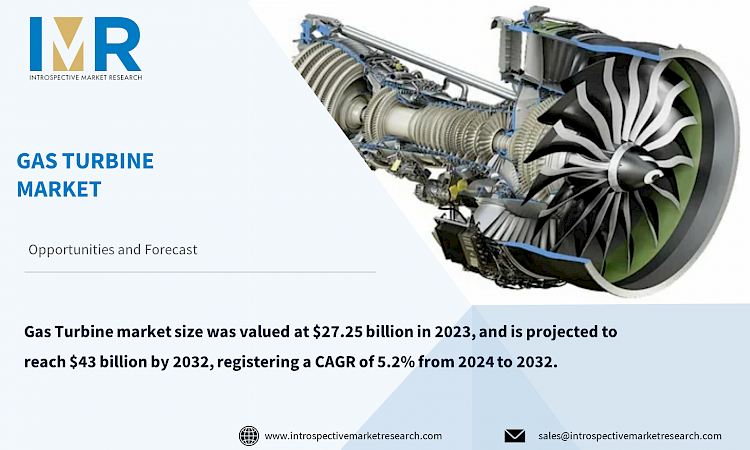
According to a new report published by Introspective Market Research, titled, “Gas Turbine Market by Capacity Type, Application, Design, Technology, End-Users: Global Opportunity Analysis and Industry Forecast, 2024–2032,” the global Gas Turbine market size was valued at $27.25 billion in 2023, and is projected to reach $43 billion by 2032, registering a CAGR of 5.2% from 2024 to 2032. Gas turbines represent a pivotal advancement in power generation technology, seamlessly converting chemical energy into mechanical energy with remarkable efficiency. However, their evolution extends beyond mere power generation. Major manufacturers have ingeniously integrated features that drive generators, enhancing dependability and lowering operational costs. Moreover, they've embraced sustainability by enabling gas turbines to be powered by clean, renewable sources, thereby mitigating carbon emissions. This shift towards eco-friendly energy solutions is particularly evident in cogeneration or combined heat and power (CHP) processes, where gas turbines efficiently produce steam from exhaust gases. This steam finds versatile applications, further amplifying the turbine's overall efficiency and contributing significantly to global efforts in carbon reduction.
The burgeoning demand for efficient turbines worldwide has spurred substantial investments from gas turbine manufacturers in advancing high-efficiency models. North America stands poised to claim a significant share of this global market, driven by a surge in initiatives and the emergence of new projects across the region.
Gas turbine engines are poised to play a significant role in the diversification of electric power generation methods. While large central power plants utilizing steam or hydraulic turbines continue to dominate, medium-sized plants incorporating gas turbine engines alongside steam turbines are gaining traction. Gas turbines offer flexibility in load demand and are well-suited for peak power production, making them attractive for various industrial applications and medium-sized marine vessels. The technology's versatility extends to its capability to operate on different fuels with minor design modifications. Moreover, advancements in modeling and simulation techniques have facilitated the optimization of gas turbine performance, leading to notable improvements in energy efficiency and fuel consumption reduction across a range of operational loads.
However, the market growth of gas turbines may face challenges due to volatility in natural gas prices. Disruptions in supply and geopolitical uncertainties contribute to fluctuations in natural gas prices, impacting the feasibility and profitability of gas turbine projects. While innovations like shale gas exploitation have reduced costs in some regions, geopolitical tensions in major gas-producing areas, such as the Middle East, introduce significant instability. These factors underscore the importance of strategic planning and risk management in navigating the evolving landscape of gas turbine technology and energy markets.
Global Gas Turbine Market, Segmentation
The Gas Turbine market is segmented on the basis of Capacity Type, Application, Design, Technology, End-Users, and region.
Capacity Type:
In the global gas turbine market, the 40-120 MW capacity segment emerges as the dominant force. This segment represents a sweet spot, offering a balance between efficiency, scalability, and operational flexibility. Gas turbines within this range are well-suited for a diverse array of applications, including medium-sized power plants, industrial facilities, and marine vessels, driving their widespread adoption. Their versatility allows for efficient power generation while meeting varying demand requirements. Advancements in technology and manufacturing processes have enhanced the performance and reliability of gas turbines in this capacity range, further cementing their position as the preferred choice for many stakeholders.
Design:
During the forecast period, the aeroderivative segment is poised to experience significant growth and dominate the market. Aeroderivative gas turbines, inspired by aircraft engines or aviation gas turbines, offer several advantages over heavy-duty gas turbines. Their design prioritizes lightweight construction, ease of installation, and rapid startup times. These characteristics make aeroderivative gas turbines highly attractive for various applications, including peaking power plants, industrial cogeneration, and distributed generation systems. Their modular design facilitates scalability, allowing for tailored solutions to meet specific power generation needs. As industries seek more efficient and agile power generation solutions, the aeroderivative segment is expected to continue its upward trajectory, driving innovation and reshaping the landscape of gas turbine technology.
Region:
Asia Pacific, an energy transition in the region must be vital in its response to climate change. Asia-Pacific countries are at different levels of development and have uneven resource funding, with diverse geographical and technological capacities. The rising spending on technological developments and increasing investment in R&D activities, combined with the rising demand for electricity utilization from economies such as China and India, are driving regional industry growth. Additionally, the quick evolution of the electricity landscape in the region is projected to lead to increased demand for the industry. The rising number of enterprises undertaken by the regional government to encourage efficient ways of generating electricity.
Key Players in the Global Gas Turbine Market
Some of the leading Gas Turbine market players are
- GE Power (U.S)
- Siemens Energy (Germany)
- Mitsubishi Power (Japan)
- Ansaldo Energia S.p.A (UAE)
- Mitsubishi Heavy Industries, Ltd. (Japan)
- Solar Turbines Inc. (U.S)
- Techno Strength Private Limited (India)
- Baker Hughes (U.S)
- Nanjing Turbine & Electric Machinery (China)
- Bharat Heavy Electricals Limited (India)
- Kawasaki Heavy Industries, Ltd. (Japan)
- John F Welch Technology Center (India)
- OPRA Turbines (Netherlands)
- MAN, Energy Solutions SE (Germany)
- Shanghai Electric Group Company Limited (China)
- Dongfang Electric Corporation (China)
- Doosan Energy Co., Ltd. (South Korea)
- Capstone Turbine Corporation (U.S)
- Centrax Gas Turbine (U.K)
- Solar Turbine International company (California)
Key Industry Developments
- In April 2023, GE Gas Power acquired Nexus Controls from Baker Hughes, creating a new full-service control business line. With the addition of this leading aftermarket control system upgrade and field service capability, GE Gas Power, part of GE Vern ova, created a single, full-service controls business line responsible for further developing GE's proprietary Mark Vle control systems platform and the implementation of the On-Core system.
- In May 2022, Siemens Energy AG announced a voluntary cash tender offer for all outstanding shares in Siemens Gamesa Renewable Energy, S.A. to delist and integrate the business. The transaction supports management's efforts to resolve the current challenges at Siemens Games Renewable Energy and generate value for the company's shareholders.
- In October 2021, Mitsubishi Heavy Industries, Ltd. (MHI) inaugurated a new structure reflecting its absorption of business previously performed by Mitsubishi Power, Ltd. Operations involving the design, manufacturing, sales, engineering, and installation of Mitsubishi Power, Ltd.'s thermal power systems have been transferred to the new "Energy Transition & Power Headquarters" established within MHI's Energy Systems domain.
Key Findings of the Study
- The global gas turbine market size was valued at $27.25 billion in 2023 and is projected to reach $43 billion by 2032, registering a CAGR of 5.2% from 2024 to 2032.
- Gas turbines are pivotal in power generation, seamlessly converting chemical energy into mechanical energy, with major manufacturers integrating features for enhanced dependability and lower operational costs.
- The 40-120 MW capacity segment dominates the market, offering efficiency, scalability, and operational flexibility for various applications, including medium-sized power plants and industrial facilities.
- Asia Pacific leads in the gas turbine market, with rising investments in technological developments and increasing demand for electricity, particularly driven by countries like China and India.




